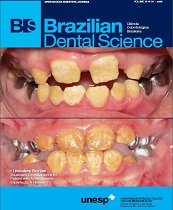Histological and microhardness evaluation of early artificial carious lesions in human and bovine enamel: in vitro study
DOI:
https://doi.org/10.14295/bds.2013.v16i4.929Abstract
Objective: Early carious lesions in bovine and humanenamel developed in vitro using a pH cycling regimenwere compared. Material and Methods: Fifteencentral bovine incisors and fifteen recently extractedhuman third molars were randomly divided into twogroups: ten for the cross-sectional microhardness test(MT) and five for polarized light microscopy (PLM)analysis. Enamel blocks measuring 5 x 5 mm weremade from the buccal face of the teeth. The blocksused for the MT were sliced into two halves: “A” and“B”. “A” slices were embedded in acrylic resin, withthe face of the dentin-enamel junction left exposedfor the MT prior to pH cycling. “B” slices and wholeblocks were coated with acid-resistant varnish,except a 3 x 3 mm central window, and submitted tothe pH cycling regimen (demineralizing solution for3 h and remineralizing solution for 21 h) over fiveconsecutive days. The “B” slices were then submittedto the MT and the whole blocks were processed forthe PLM study. Results: The PLM analysis revealedshallow, extensive lesions in the bovine enamel,hardly showing the superficial, dark and translucentzones, as well as deep cavity lesions in the humanenamel, with the body of the lesion and the darkzone evident. The MT revealed a significant decreasein microhardness in the superficial levels of thebovine enamel caries and at all depth levels of thehuman enamel caries. Conclusion: The pH cyclingregimen adopted led to the development of deeperand more demineralized carious lesions in humanenamel than bovine enamel
Keywords
Dental caries; Dental enamel; Microhardness tests; Polarization microscopy.
Downloads
Downloads
Additional Files
Published
How to Cite
Issue
Section
License
Brazilian Dental Science uses the Creative Commons (CC-BY 4.0) license, thus preserving the integrity of articles in an open access environment. The journal allows the author to retain publishing rights without restrictions.
=================




























